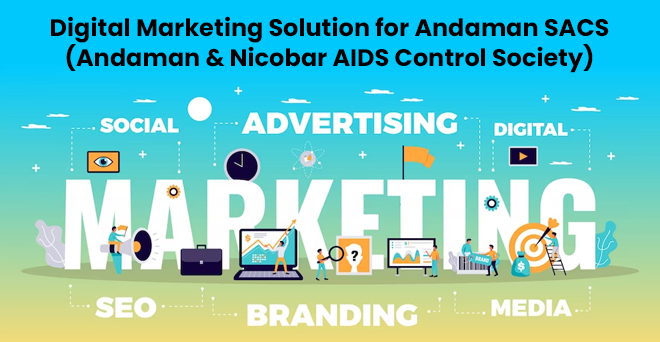
Problem Statement:
Andaman State AIDS Control Society (Andaman SACS) struggled to effectively raise awareness about HIV/AIDS and combat the prevailing stigma in the local community. They lacked an engaging way to communicate vital information, resulting in limited outreach and low engagement levels. They had their messages but had no in-house social media team or even strategy to convey those to their target audience effectively.
Strategy:
Shyam Future Tech partnered with Andaman SACS to develop a comprehensive digital marketing strategy to address these challenges. The strategy focused on leveraging the power of digital social media platforms like Facebook, Twitter & Instagram to increase awareness, change behaviors, and promote a stigma-free environment regarding HIV/AIDS. It involved creating powerful social media messages with text and images through regular social media calendars and then promoting them in the diverse social networks.
Social Media Marketing Strategy:
1. Audience Research and Persona Development:
Shyam Future Tech initiated the project by conducting in-depth audience research to understand the demographics, preferences, behaviors, and pain points of the target audience. This research helped in creating detailed audience personas, enabling personalized and relevant content creation.
2. Content Strategy:
The content strategy revolved around providing accurate information while focusing on emotional storytelling to humanize the issue of HIV/AIDS. Shyam Future Tech developed a mix of content types, including:
Educational Posts: Informative graphics, short videos, and carousel posts explaining HIV/AIDS facts, transmission, prevention, and treatment.
Personal Stories: Real-life stories of individuals living with HIV/AIDS, showcasing their resilience, challenges, and successes.
Myth-Busting Content: Addressing common misconceptions and myths surrounding HIV/AIDS to dispel stigma and misinformation.
Interactive Campaigns: Quizzes, polls, challenges, and hashtags to encourage audience participation and foster a sense of community.
3. Platform Selection and Optimization:
Based on audience research, the team identified key social media platforms preferred by the local population. Profiles were optimized with relevant keywords, appealing visuals, and consistent branding to establish a cohesive online presence.
4. Content Calendar and Consistency:
Shyam Future Tech devised a content calendar to ensure a regular posting schedule, maintaining audience interest and engagement. This calendar encompassed thematic campaigns aligned with national or global HIV/AIDS awareness events.
5. Influencer Partnerships:
The team identified local influencers, activists, and advocates who had credibility in discussing health-related topics. These influencers were approached for collaborations, amplifying the reach and authenticity of the awareness campaigns.
6. Engaging Campaigns:
Shyam Future Tech launched engaging campaigns to create more awareness around HIV/AIDS.
7. Analytics and Iteration:
The strategy included constant monitoring of key performance indicators (KPIs) such as engagement rate, reach, shares, and comments. Insights from analytics were used to refine content, posting times, and campaign strategies.
Results:
Significant Reach and Engagement Increase: Shyam Future Tech’s strategy led to a notable increase in followers, likes, shares, and comments, indicating improved engagement.
Stigma Reduction: Through personal stories and myth-busting content, the project contributed to diminishing stigma associated with HIV/AIDS in the local community.
Empowered Community: The campaigns fostered a supportive and informed online community, encouraging open conversations about HIV/AIDS.
Conclusion: Shyam Future Tech’s focused social media marketing strategy successfully transformed Andaman SACS’s digital presence. By leveraging engaging content, strategic collaborations, and data-driven optimization, the project effectively increased awareness, reduced stigma, and fostered a more supportive and educated community in the fight against HIV/AIDS. This case study highlights the power of social media in addressing sensitive societal issues and promoting positive change.